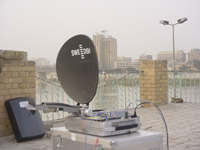Portable news links
The war in Iraq was marked by a phenomenal increase in the mobility of live news reports, with reporters and cameramen filing anywhere, from tanks and troop carriers on the move to positions where they were hunkered down under fire — live in every sense. The first Gulf War saw satellite news gathering (SNG) come of age, and the latest conflict was another milestone in news gathering history for the newest and most portable of news links, delivering live reports in a manner that was often breathtaking.

Shown here is the Swe-Dish IPT Suitcase, in use last March by Al Jazeera to report live from Baghdad.
Portable news links, which have emerged in the last few years, broadly fall into two types. There are compact versions of traditional Ku-band SNG uplinks and videophone units based on using the Inmarsat satphone system. The compact Ku-band links offer data rates of up to 2Mb/s to 6Mb/s, while Inmarsat units are used at 64kb/s to 28kb/s. Of course, the Inmarsat units produce a much lower-quality picture. However, for easy use, rapid deployment, dial-on-demand connectivity, and low capital and running cost, they hold a unique position in the news gathering armory.
In the compact Ku-band flyaway arena, two companies currently dominate — Norsat and Swe-Dish. These mini-flyaways feature antennas below 1 meter in diameter, highly integrated electronics packages including MPEG-2 encoding, modulation and upconversion and downconversion, and typically 25W SSPAs. Such low-power units are feasible because of the latest generation of satellites with their high-power spot and zone beams.
The Norsat NewsLink was used by the USA’s CBS and Fox News to great effect and offered MPEG-2 transmission at speeds of up to 5Mb/s to 6Mb/s. Embedded with frontline U.S. Army units, they enabled teams to move rapidly with the troops. The NewsLink comes in two pieces — the quick assembly 1-meter antenna and the electronics package. Together they weigh 46kg. System setup is 10 minutes without tools and comes complete with a compass, inclinometer and GPS to aid alignment. Norsat has sold units to Sky News (UK), an unnamed Hong Kong broadcaster and KTUU (Alaska’s largest TV station and Anchorage’s NBC affiliate). Even the U.S. Department of Defense Media has a NewsLink in Iraq to send stories back for U.S. stations to use.
The Swe-Dish IPT (IP Terminal) Suitcase is a smaller and lighter 39kg single-piece package. It features a motorized sub-1-meter antenna and laptop-based software to set all the transmission parameters. Antenna positioning is semi-automated using a built-in GPS and flux-gate compass, requiring less-skilled personnel than with a traditional flyaway design such as the Norsat NewsLink. Typical field setup can be achieved in less than five minutes. With MPEG-2 transmissions at a maximum data rate of 2Mb/s, a compromise on quality is required compared to the NewsLink. Nevertheless, the lower skill level required in use is attractive in these times of slimming numbers in the field. Al Jazeera (Qatar), KBS (Korea), MBC (Korea), NDTV (India), NHK TV (Japan), Nippon TV (Japan), Oman TV (Oman), ORT (Russia), SVT (Sweden) and Telewizja Polska (Poland) have all bought IPTs.
Inmarsat-based systems use H.261/263 video-conferencing protocols, characterized by the 7E Communications Talking Head (TH) Video Reporter unit — the videophone — which is used with one or two Inmarsat Global Area Network (GAN) satphones, depending on the desired data-rate/quality. A single GAN satphone has a fixed speed of 64kb/s, so combining two satphones gives 128kb/s. The first unit on the market to offer easy journalist operation, the TH videophone doesn’t actually have a built-in camera. It’s used with a normal DVCAM camera (the pictures actually look poorer with a full broadcast spec camera), and TH videphone pictures were seen from virtually all the major broadcasters active in the theater.
Get the TV Tech Newsletter
The professional video industry's #1 source for news, trends and product and tech information. Sign up below.
Meanwhile, the roll-out of third-generation UMTS (3G) mobile phone services has produced hand-held videophones as integrated camera mobiles. These 3G services are already available in a several countries, and the hope is that they will be global by 2005. The BBC already has transmitted live 3G phone pictures, scooping competing news networks.
For the future, the decrease in size of Ku-band flyaway antennas has reached a limit imposed by physics with the power of current satellites. With continuing developments in video compression through the recently ratified ITU H.264/AVC standard, we’ll see advances in low bit-rate video quality over the next few years as manufacturers develop news links based on the new standard — but the timescale in years is due to the huge amount of processing power required for H.264 encoding.
We’ll soon be seeing reporters pushing forward with 3G video-phones and pointing over the heads of the crowd to catch live shots of the spokesman for the all-important video bite, but there’s little doubt that the full range of link solutions will continue to be popular.
Jonathan Higgins heads a satellite communications consultancy firm in the UK. He is the author of two books on satellite newsgathering, the second of which, “Introduction to SNG and ENG Microwave,” has just been published by Focal Press.
